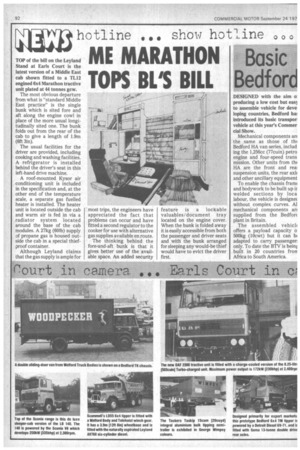hotline ..• show hotline
Page 94

If you've noticed an error in this article please click here to report it so we can fix it.
ME MARATHON TOPS BL'S BILL
TOP of the bill on the Leyland Stand at Earls Court is the latest version of a Middle East cab shown fitted to a TL12 engined 6x4 Marathon tractive unit plated at 44 tonnes gcw.
The most obvious departure from what is "standard Middle East practice" is the single bunk which is sited fore and aft along the engine cowl in place of the More usual longitudinally sited one. The bunk folds -out from the rear of the cab to give a length of 1.9m (6ft 3in).
The usual facilities for the driver are provided, including cooking and washing facilities. A refrigerator is installed behind the driver's seat in this left-hand drive machine.
A roof-mounted Kysor air , conditioning unit is included in the specification and, at the other end of the temperature scale, a separate gas fuelled heater is installed. The heater unit is located outside the cab and warm air is fed in via a radiator system located around the base of the • cab modules. A 27kg (601b) supply of propane gas is housed out' side the cab in a special thiefproof container.
Although Leyland claims that the gas supply is ample for most trips, the engineers have appreciated the fact that problems can occur and have fitted a second regulator to the cooker for use with alternative gas supplies available en route.
The thinking behind the fore-and-aft bunk is that it gives better use of the available space. An added security feature is a lockable valuables/document tray located on the engine cover. When the bunk is folded away it is easily accessible from both the passenger and driver seats and with the bunk arranged for sleeping any would-be thief would have to evict the driver first.




































































































































































































































































































































































